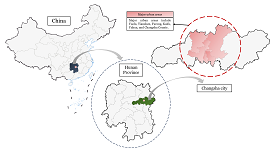
Asia Pacific Academy of Science Pte. Ltd. (APACSCI) specializes in international journal publishing. APACSCI adopts the open access publishing model and provides an important communication bridge for academic groups whose interest fields include engineering, technology, medicine, computer, mathematics, agriculture and forestry, and environment.

As China's pillar industry, the property market has suffered a considerable impact in recent years, with a decline in turnover and many developers at risk of bankruptcy. As one of the most concerned factors for stakeholders, housing prices need to be predicted more objectively and accurately to minimize decision-making errors by developers and consumers. Many prediction models in recent years have been unfriendly to consumers due to technical difficulties, high data demand, and varying factors affecting house prices in different regions. A uniform model across the country cannot capture local differences accurately, so this study compares and analyses the fitting effects of multiple machine learning models using February 2024 new building data in Changsha as an example, aiming to provide consumers with a simple and practical reference for prediction methods. The modeling exploration applies several regression techniques based on machine learning algorithms, such as Stepwise regression, Robust regression, Lasso regression, Ridge regression, Ordinary Least Squares (OLS) regression, Extreme Gradient Boosted regression (XGBoost), and Random Forest (RF) regression. These algorithms are used to construct forecasting models, and the best-performing model is selected by conducting a comparative analysis of the forecasting errors obtained between these models. The research found that machine learning is a practical approach to property price prediction, with least squares regression and Lasso regression providing relatively more convincing results.
Urban culture from the inhabitant in the coastal zone of the Department of Córdoba-Colombia
Vol 3, Issue 1, 2022
Download PDF
Abstract
Keywords
References
- Gravano A. Antropología de lo urbano. Santiago de Chile: LOM Ediciones; 2016.
- Silva A. Imaginarios urbanos, Bogotá y São Paulo: cultura y comunicación urbana en América Latina. Bogotá: Tercer Mundo Editores; 2000.
- Hernández AMJ. Participatory urbanism: social construction of urban space. Architecture Journal. 2016; 18(1): 6–17.
- Silva A. Imaginarios urbanos: hacia el desarrollo de un urbanismo desde los imaginarios. Metodología. Bogotá: Convenio Andrés Bello, Universidad Nacional de Colombia; 2004.
- Rionda J. Thinking the city from the perspective of the territory. Urban. 2008; 11(17): 76–82. City Diversity 2022, 3(1), 1931. 12
- Vega Martínez AA, Hernández Buelvas EJ, Barbera Alvarado N. Territorial configuration of habitat in the Alfonso López informal settlement in the city of Montería–Colombia. Revista INVI 2019; 34(97): 81–103.
- Tuirán A, De la Rosa I, Mercado A. Local governance in the department of Córdoba. Barranquilla: Observatorio de Gobernabilidad Local, Centro de Pensamiento uncaribe, Universidad del Norte; 2018.
- Hernández R, Fernández C, Baptista P. Research methodology. Mexico: Mcgraw Hill; 2014.
- Hidalgo R, Alvarado V, Arenas F, et al. The dissident community: reaction, methods and socio-spatial conflict in the coastal edge of the Valparaíso Region. ACE: Architecture, City and Environment. 2016; 10(30): 31–56.
- Martínez C, Rojas C, Rojas O, et al. Urban growth on coastal geoforms of the San Pedro plain, Metropolitan Area of Concepción. In Hidalgo R, Santana D, Alvarado V, et al. (editors). On the Coasts of Neoliberalism. Naturaleza, Urbanización y Producción inmobiliaria. Chile: Instituto de Geografía, Pontificia Universidad Católica de Chile; 2016. pp. 287–312.
- Martí–Ciriquián P, García-Mayor C. Maritime–river fronts in Spanish cities: new urban spaces. Bitácora Urbano Territorial. 2018; 28(3): 71–79.
- Valdebenito RMG, & Rodríguez MA. Neoliberalism and socio–spatial transformations in urban coves of the Metropolitan Area of Concepción: the cases of Caleta Los Bagres and Caleta Cocholgüe, Tomé. Revista de Urbanismo. 2018; 38(38): 1– 17.
- Lefebvre H, Lorea I. The production of space. Madrid: Capitán Swing; 2013. pp. 31–50.
- Sánchez C. Imagination and society: A creative hermeneutics of culture. In: TecnosSA. Santos M (editors). The nature of space. Barcelona: Editorial Ariel; 2000.
- Guerrero–Cossio V. Recent transformations in Iquique: the new coastal subject. Diálogo Andino. 2016; (51): 73–80.
- Lazzarotti O. L'"habiter", sur un plateau. Annales de Géographie. 2015; 704(4): 335–337.
- Yory C. From occupied space to inhabited place: an approach to the concept of topophilia. Revista Barrio Taller; 2007.
- Rubilar L. Valuation of the urban landscapes of the central coastal edge. A strategy to rescue their identity. Case: Cartagen a– Region of Valparaíso–Chile (Doctoral thesis). University of Seville, Seville, Spain; 2015.
- Barbera N, Payares L, Camejo L, Chirinos, Y. Nuances of sustainable development planning from complexity. In Chirinos Y, Ramírez A, Barbera N, et al. (editors). Tendencias en la Investigación Universitaria: una visión desde Latinoamérica. Venezuela: Fondo Editorial Universitario Servando Garcés de la Universidad Politécnica Territorial Alonso Gamero; 2018.
- Martínez AAV, Buelvas EJH, Padilla CCM. Urban culture from social imaginaries in the informal settlement El Níspero in the city of Montería, Colombia. In Chirinos Y, Ramírez A, Barbera N, & Rojas D (editors), Tendencias en la Investigación Universitaria: una visión desde Latinoamérica. Venezuela: Fondo Editorial Universitario Servando Garcés de la Universidad Politécnica Territorial Alonso Gamero; 2019. pp. 101–117.
- Zarate M. Cultural landscapes through cases in Spain and the Americas (Spanish). Madrid: UNED; 2016.
- Escolano–Utrilla S, López–Escolano C, & Pueyo–Campos Á. Neoliberal urbanism and urban fragmentation: the case of Zaragoza (Spain) in the first fifteen years of the 21st century. Latin American Journal of Urban –Regional Studies. 2018; 44(132): 185–212.
- Costa S, Carmo M, Barja P. The urban hierarchy at the delta of the Amazon River and the importance of small cities. Revista Brasileira de Gestão Urbana. 2019; 11: e20180014.
Supporting Agencies
Copyright (c) 2022 Arney Alfonso Vega Martínez, Efraín de Jesus Hernández Buelvas, Nataliya Barbera Alvarado, Emilio Francisco Flórez Ruíz

This work is licensed under a Creative Commons Attribution 4.0 International License.

This site is licensed under a Creative Commons Attribution 4.0 International License (CC BY 4.0).

Prof. Mehmet Cetin
Kastamonu University,
Turkey
Polish Scientific Bibliography

